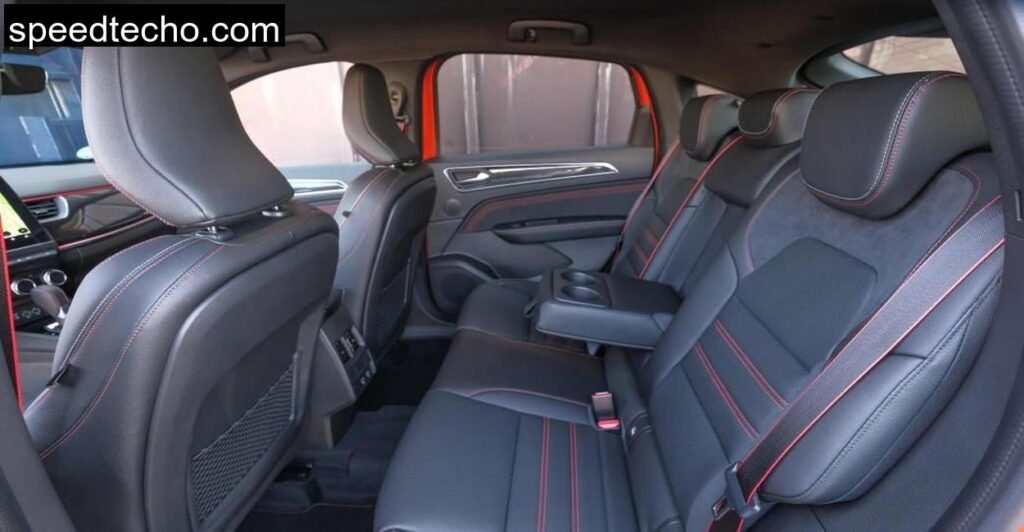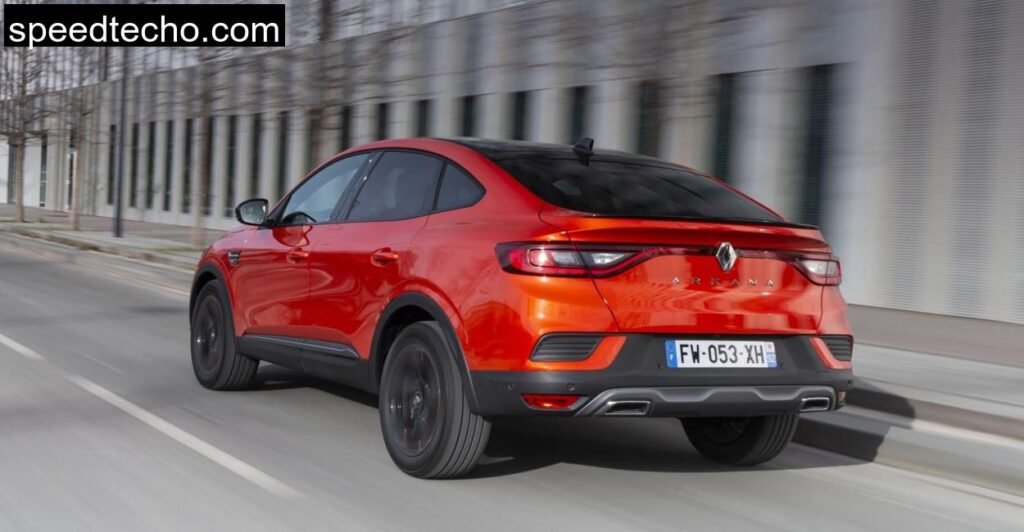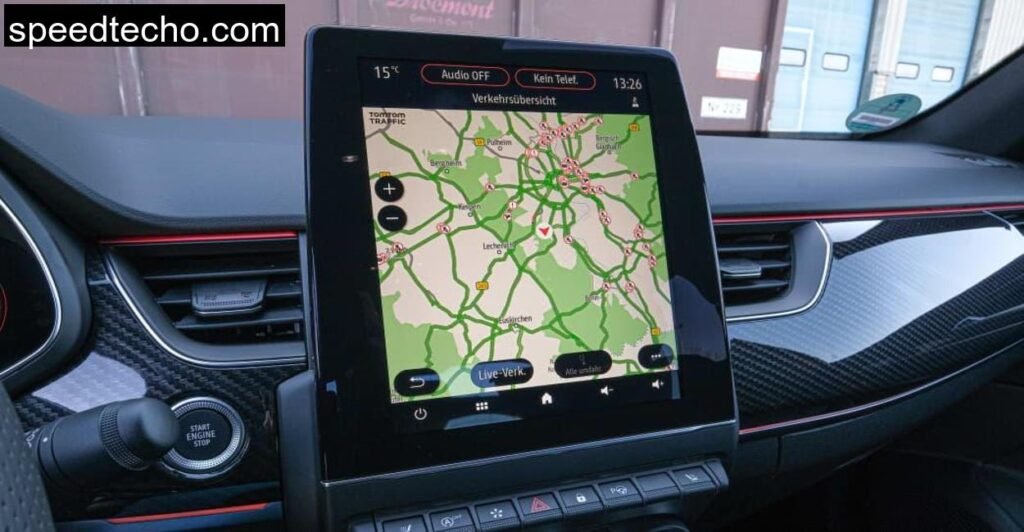The Design: A French Curveball in the SUV Game
The Arkana is one of those rare designs that doesn’t need a badge to be recognized. Even before I stepped in, I stood for a moment admiring its profile, sweeping roofline, 20 cm of ground clearance, and muscular fenders sitting over 18, inch wheels (19 on the Esprit Alpine). Renault didn’t shy away from boldness here. It’s got the visual drama of a coupé and the stance of a proper SUV. The facelift for 2024 sharpened that front fascia, with a redesigned grille holding the new Renault logo like a proud medal.
At 4.57 meters long and just 1.57 meters tall, it cuts a lithe silhouette through the underbrush of tall SUVs. I won’t lie, people in nearby Bad Karlshafen turned their heads. The Arkana might not scream “luxury” like the GLC Coupé, but it whispers something more honest: personality.
Interior and Comfort: More Than Just Form
I slid into the Esprit Alpine version, greeted by Alcantara upholstery and blue contrast stitching that gave it a slightly sporty edge without being too much. The leather, wrapped steering wheel felt great in hand, thick, soft, and grippy. The new 9.3, inch vertical infotainment screen tilted ever so slightly toward me, flanked by digital dials that can be customized with two button presses. Renault’s UI isn’t the most intuitive (there’s still a bit of menu, hopping for simple things), but Android Auto connected without fuss, and the optional wireless charging pad kept my phone alive during a full, day test.
Space, wise, this five, door holds its own. I’m just under 1.85 meters tall, and with the front seat set for me, I could still comfortably sit behind myself. You don’t feel squeezed in, which is impressive considering the sloping roofline. Renault claims that even adults up to 1.95 meters can fit in the front and rear, and I believe them. The 2.72, meter wheelbase helps here.
The boot was a pleasant surprise. Even with the hybrid’s slightly smaller storage capacity (480 liters instead of 513 in the mild, hybrid), I was able to fit my full mountain bike gear, including helmet, shoes, and tools, without folding the seats. But when I did drop them, the total capacity shot up past 1,260 liters. That’s more than enough for a long weekend getaway or a bike, packing trip into the low mountain ranges.

On the Road: Driving the Arkana in the Kiffing
It’s not often I get to push a hybrid hard through dense forest roads, but the Kiffing gave me the perfect playground. I tested both versions: the 140 hp TCe mild hybrid with the 7, speed EDC dual, clutch transmission and the 143 hp E, Tech full hybrid with its multi, mode gearbox.
The mild, hybrid 140 TCe pulled better than expected. With 260 Nm of torque delivered smoothly from low revs, overtaking on the country roads outside Lippoldsberg wasn’t an issue. It felt composed, never thrilling, but always willing. The gearbox was a mixed bag though. Shifts were quick under load, but crawling through the narrow alleys of Oedelsheim, the dual, clutch hesitated a beat too long when moving off from a stop. Still, the 9.8, second 0, 100 km/h time felt believable, and even on motorway stretches, it cruised happily at 130 km/h.
The full hybrid told a different story. At lower speeds, especially in towns like Fürstenberg, the car was eerily quiet, gliding along in full EV mode. Its 1.2 kWh battery doesn’t enable long electric, only ranges, but it’s perfect for school runs or village cruising. With 143 hp and a 172 km/h top speed, it wasn’t blistering, but it never felt underpowered either. Where it really shined was in fuel economy. Even with climbs and tight turns through the forest, I averaged just 5.3 liters per 100 km. Compare that to the 6.8 I got with the mild hybrid, and the difference is real.
Handling, Ride Quality, and Steering Feel
Renault nailed the chassis tuning. The Arkana sits in that sweet spot, firm enough to handle winding switchbacks, soft enough to smooth out gravel sections. In Kiffing’s patchwork of road surfaces, from perfect asphalt to leafy gravel paths, the suspension soaked up imperfections with ease. It’s no canyon carver, but for a front, wheel, drive SUV, it held its own remarkably well.
If there’s one place where the French SUV still feels like it could use some German engineering, it’s the steering. It’s light, very light, and while that’s fine for cities or tight parking, I wanted more weight and feel on spirited drives. You can tweak the drive mode to Sport and get a bit more heft, but don’t expect BMW, style precision. Still, the stability at speed, even on fast autobahn bends, was excellent. And during a quick ADAC, style evasive maneuver on a quiet clearing, both hybrids stayed planted thanks to the well, calibrated ESP.

Tech and Driver Assistance: Everything You Need
Both versions I tested came loaded with tech. Emergency braking, lane keep assist, adaptive cruise control, blind spot monitoring, all there. The 360, degree camera helped navigate tight woodland tracks where tree branches threatened to scratch the paint. Parking in the old village lots was a breeze with the auto, park assist.
The Techno and Esprit Alpine trims offer solid upgrades, bigger screens, digital instruments, heated seats and steering wheel, and even traffic jam assistance. The only thing I missed was physical knobs for volume and climate. Renault, please bring those back.

Fuel Efficiency and Emissions
Here’s where the Arkana shows its smarts. Real, world consumption matters more than brochure numbers, and I drove both trims for over 400 km each in mixed driving. The TCe 140 averaged around 6.8, 7.0 liters/100 km, slightly higher than WLTP but understandable considering the terrain. The E, Tech Hybrid, however, stayed steady at 5.2, 5.4 liters/100 km, making it the clear winner if efficiency is your priority.
Pollutant emissions were impressively low in both cars, thanks to Renault’s use of particulate filters even on the mild hybrid. The Arkana Hybrid also earned 4 out of 5 stars in the ADAC EcoTest, a clear indication that Renault has their emissions strategy figured out.
Conclusion: Arkana Nails the SUV Coupé Brief, Affordably
The Renault Arkana surprised me. It wasn’t the most powerful, the fastest, or the most luxurious SUV coupé I’ve driven, but it felt right. It’s not pretending to be a BMW or a Mercedes. It knows it’s the accessible alternative, and plays that role beautifully. The design is bold, the tech is competent, the boot is genuinely useful, and the hybrid powertrain rewards smooth driving with real, world savings.
In the Kiffing, it felt at home, confident on narrow forest roads, comfortable over long stretches, and stylish enough to turn heads in sleepy German towns. Whether you go for the punchier mild hybrid or the more frugal E, Tech full hybrid, the Arkana delivers on its promise: Coupé cool with SUV practicality.
Is the Renault Arkana a real SUV or more of a crossover?
It’s more of a crossover with SUV styling. No all, wheel drive, but good ground clearance and seating position.
Which version of Arkana should I choose for best efficiency?
The E, Tech Hybrid 145 is clearly more efficient, especially in city driving. If you value lower fuel costs and do a lot of urban riding, it’s the better pick.
How does Arkana compare to premium SUV coupes?
It costs much less, uses less fuel, and offers similar interior space. It lacks some refinement and prestige, but makes up for it with smart design and honest capability.






